If you’ve been wondering about selling microgreens as a business opportunity, you’re looking at one of the most profitable crops in agriculture today. With prices ranging from $25-$50 per pound and the ability to grow year-round in small spaces, microgreens farming has become an attractive option for both seasoned farmers and newcomers to agriculture.
Quick Profit Overview
- Weekly Earnings: $300-$1000+ possible
- Price Range: $25-$50 per pound
- Growing Time: 7-14 days per harvest
- Space Required: Can start in 50-75 sq ft
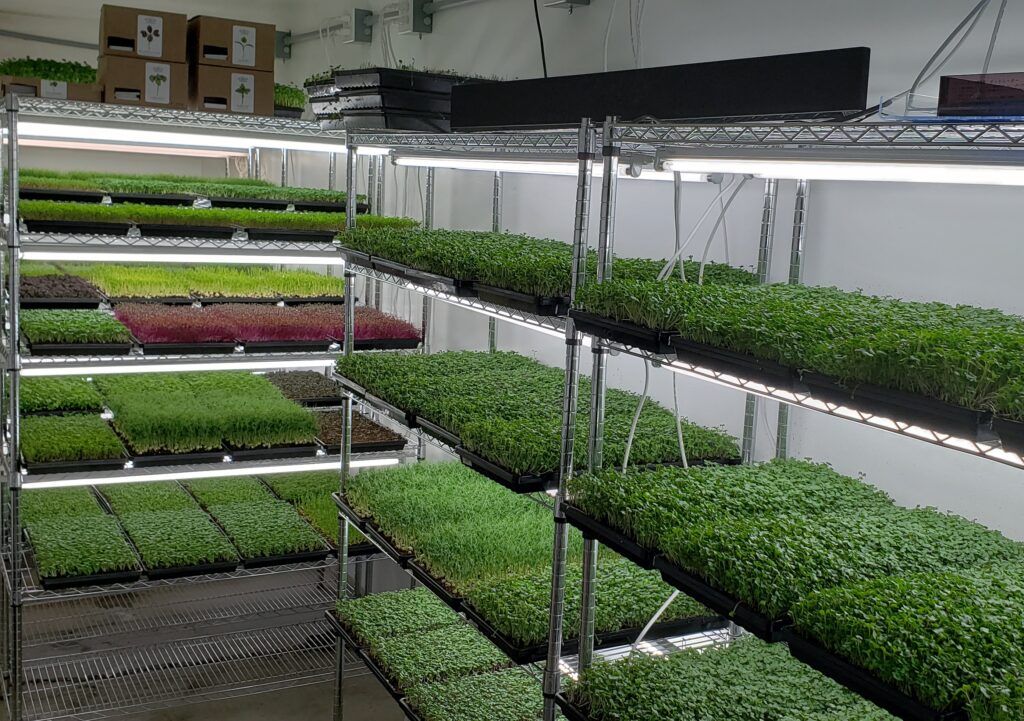
The Microgreens Market: Why Selling Microgreens is So Profitable
The microgreens industry has experienced explosive growth, driven by increasing health consciousness and demand from restaurants for fresh, local ingredients. When you’re selling microgreens, you’re tapping into a market that values quality, nutrition, and consistent supply.
Market Demand Drivers
- Restaurant industry growth
- Health-conscious consumers
- Local food movement
- Year-round fresh produce demand
Competitive Advantages
- Quick turnaround (7-14 days)
- Small space requirements
- High profit margins
- Consistent year-round production
Microgreens Profit Potential by Scale
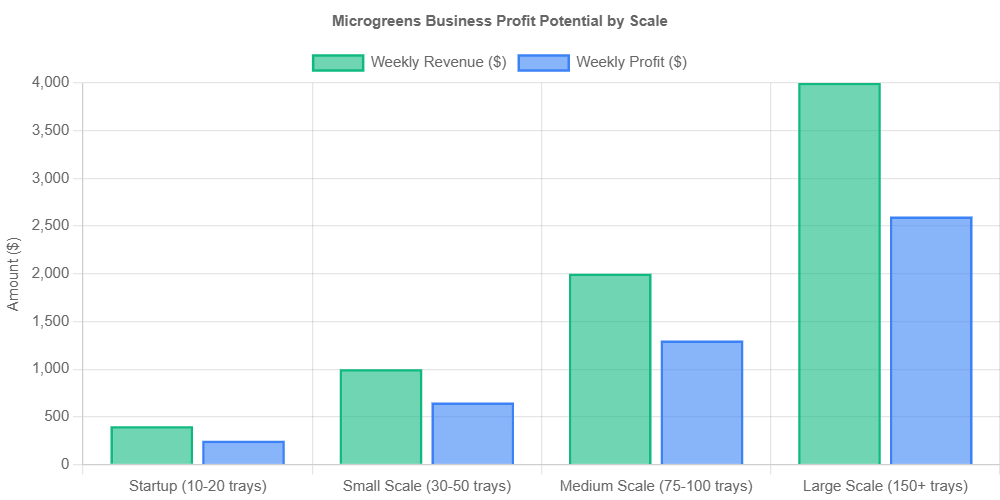
How to Start Selling Microgreens: Step-by-Step Setup
Starting your microgreens selling business requires careful planning and understanding of both the growing process and business requirements. Here’s your complete roadmap to begin selling microgreens profitably.
1. Business Planning and Market Research
Before you start selling microgreens, identify your target market and understand local demand. Research restaurants, farmers markets, and grocery stores in your area to determine where you can sell microgreens most effectively.
- Survey local restaurants about their microgreens needs
- Visit farmers markets to understand pricing and competition
- Contact grocery stores about their local sourcing policies
- Analyze online selling opportunities in your region
2. Growing Setup and Equipment
Your growing setup directly impacts your ability to maintain consistent supply when selling microgreens. Start with a system that can scale as your business grows.
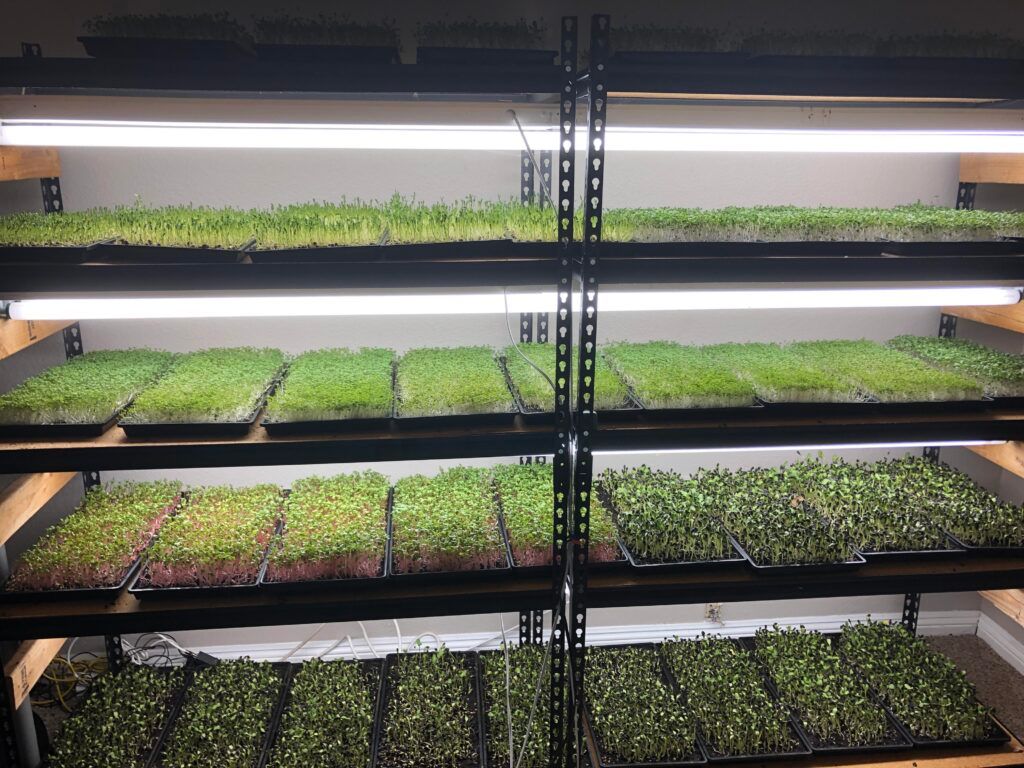
Essential Equipment for Selling Microgreens:
- 1020 growing trays (solid and perforated)
- Growing racks with LED lighting
- Heat mats for germination
- Growing medium (soil or hydroponic)
- Quality seeds from reputable suppliers
- Packaging materials and labels
- Scale for weighing produce
- Storage containers and refrigeration
3. Seed Selection and Variety Planning
When selling microgreens, variety selection impacts both your profit margins and customer satisfaction. Some varieties command higher prices and grow more reliably.
Popular Varieties and Pricing for Selling Microgreens:
| Microgreen Variety | Taste & Use | Growth Time | Avg. Price (USD per 100g) |
| Sunflower | Nutty, crunchy – good for salads, snacks | 7–10 days | $3.00 – $5.00 |
| Pea Shoots | Sweet, fresh – stir-fries, garnishes | 10–14 days | $2.50 – $4.00 |
| Radish (Red/Daikon) | Spicy, peppery – toppings, detox diets | 6–10 days | $3.00 – $5.00 |
| Broccoli | Mild, earthy – juices, smoothies | 6–9 days | $3.50 – $6.00 |
| Wheatgrass | Strong, grassy – mainly for juicing | 7–10 days | $2.00 – $3.50 |
| Cilantro (Coriander) | Strong flavor – Indian cuisine, garnishes | 14–20 days | $4.00 – $6.50 |
| Basil | Intense basil aroma – Italian dishes | 12–16 days | $4.00 – $7.00 |
| Mustard | Spicy, bold – sandwiches, spice dishes | 6–10 days | $2.50 – $4.00 |
| Amaranth (Red) | Mild, sweet – bright color for visuals | 7–12 days | $3.50 – $5.50 |
How to Set Pricing for Your Microgreens
- Start low if you’re new and build trust.
- Price based on variety, packaging, and delivery cost.
- Organic or hydroponic-grown microgreens may demand premium rates.
- B2B pricing (bulk to restaurants): Slightly lower per 100g.
- B2C pricing (retail to customers): Higher margins possible.
Bonus Tips for Selling
- Offer weekly subscription boxes.
- Sell on platforms like Instagram, WhatsApp, BigBasket Local, etc.
- Partner with local cafes or organic stores.
- Use eco-friendly packaging to attract health-conscious buyers.
Legal Requirements for Selling Microgreens
Understanding the legal requirements for selling microgreens is crucial for operating a legitimate business. While requirements vary by location, here are the common licenses and permits you’ll need when selling microgreens.
Important Legal Notice
Always check with your local and state authorities for specific requirements in your area. Legal requirements for selling microgreens can vary significantly by jurisdiction.
Essential Licenses and Permits
Business License
Required in most jurisdictions to legally operate when selling microgreens as a business.
Sales Tax Permit
Needed to collect and remit sales tax on microgreens sales in most states.
Food Handler’s Permit
Required for handling food products when selling microgreens to restaurants and retailers.
Additional Considerations
FDA Compliance
Microgreens must comply with FDA produce safety rules for growing, harvesting, and packaging.
Organic Certification
Optional but valuable for premium pricing when selling microgreens to health-conscious markets.
Vendor Permits
Required for selling microgreens at farmers markets and some retail locations.
Where to Sell Microgreens: Best Sales Channels for Maximum Profit
Choosing the right sales channels is critical for success when selling microgreens. Each channel has different requirements, profit margins, and volume potential. Here’s where you can sell microgreens most effectively.
Selling Microgreens to Restaurants
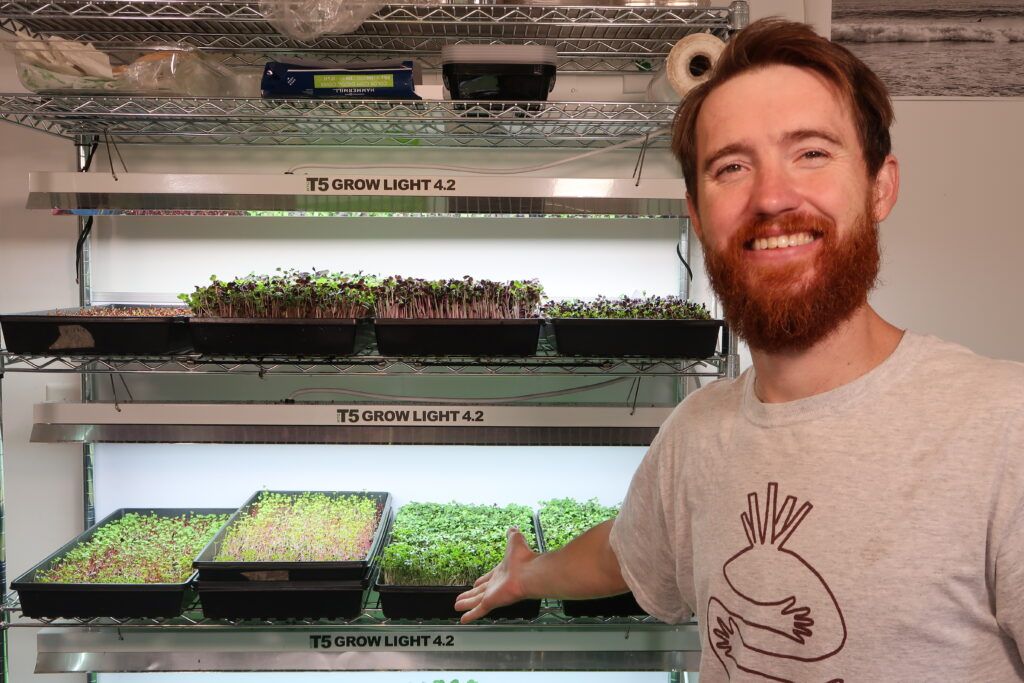
Restaurants are often the most profitable channel for selling microgreens, offering consistent volume and premium pricing for quality products.
Advantages:
- Higher price points ($3-6 per ounce)
- Consistent weekly orders
- Direct customer relationships
- Volume purchasing
Best Practices:
- Provide samples to head chefs
- Maintain consistent quality and timing
- Offer variety packs and seasonal specials
- Build relationships with multiple restaurants
Farmers Markets
Farmers markets provide direct-to-consumer sales opportunities and help build brand awareness for your microgreens business.
Benefits:
- Direct customer feedback
- Premium retail pricing
- Brand building opportunities
- Community connections
Success Tips:
- Attractive display and sampling
- Educational materials about microgreens
- Consistent market presence
- Recipe cards and usage suggestions
Online Selling Microgreens
Selling microgreens online expands your reach and allows for subscription-based models and direct-to-consumer delivery.
Online Platforms:
- Your own website with e-commerce
- Local delivery apps and platforms
- Social media marketplaces
- Community-supported agriculture (CSA)
Key Considerations:
- Packaging for shipping
- Delivery logistics and timing
- Online payment processing
- Customer service and support
Grocery Stores and Retailers
Grocery stores offer volume opportunities but require consistent supply and competitive pricing when selling microgreens.
Requirements:
- Consistent weekly volume
- Professional packaging and labeling
- Competitive wholesale pricing
- Reliability and quality standards
Approach Strategy:
- Start with local independent stores
- Provide product samples and information
- Offer promotional support
- Build track record before approaching chains
How Much to Charge: Microgreens Pricing Strategies for Maximum Profit
Pricing your microgreens correctly is essential for profitability. Understanding market rates and your costs helps you set competitive prices while maintaining healthy margins when selling microgreens.
Current Market Pricing for Selling Microgreens
$25-40
Wholesale per pound
$40-60
Retail per pound
$12-18
Profit per tray
Pricing by Sales Channel
| Sales Channel | Price per Ounce | Volume Potential | Profit Margin |
|---|---|---|---|
| Restaurants | $3.00 – $6.00 | Medium-High | High |
| Farmers Markets | $4.00 – $8.00 | Low-Medium | Very High |
| Online Direct | $3.50 – $7.00 | Variable | High |
| Grocery Wholesale | $1.50 – $2.50 | High | Medium |
Cost Calculation for Selling Microgreens
Understanding your costs is crucial for profitable pricing when selling microgreens. Here’s a typical cost breakdown per tray:
Direct Costs per Tray:
- Seeds: $0.50 – $2.00
- Growing medium: $0.25 – $0.75
- Packaging: $0.25 – $0.50
- Labels: $0.10 – $0.25
Overhead Costs:
- Electricity: $0.50 – $1.00
- Water: $0.10 – $0.25
- Labor: $1.00 – $3.00
- Transportation: $0.25 – $0.75
Total Cost per Tray: $2.95 – $8.50
Revenue per Tray: $12.00 – $30.00
Net Profit per Tray: $9.05 – $21.50
Business Operations: Scaling Your Microgreens Sales
Successfully selling microgreens requires efficient operations, quality control, and strategic scaling. Here’s how to build a sustainable business that can grow from a side project to full-time income.
Production Planning and Scheduling
Consistent supply is crucial when selling microgreens. Plan your production cycles to meet customer demand without overproducing.
Weekly Production Schedule:
- Monday: Seed new trays, harvest ready crops
- Tuesday: Package and deliver to restaurants
- Wednesday: Seed replacement trays
- Thursday: Prepare for farmers market
- Friday: Quality check and inventory
- Saturday: Farmers market sales
- Sunday: Plan next week’s production
Growth Tracking:
- Track germination rates by variety
- Monitor growth conditions and adjust
- Record yield per tray for pricing
- Document customer preferences
- Track seasonal demand patterns
Quality Control and Food Safety
Maintaining high quality is essential for customer retention when selling microgreens. Implement consistent quality control processes.
Growing Standards:
- Use clean, filtered water for all watering
- Maintain proper temperature and humidity levels
- Sanitize all equipment between uses
- Inspect crops daily for signs of disease or pests
Harvesting and Packaging:
- Harvest at optimal maturity for best flavor
- Handle gently to avoid bruising
- Package in clean, food-safe containers
- Label with harvest date and variety
Scaling Strategies for Growing Sales
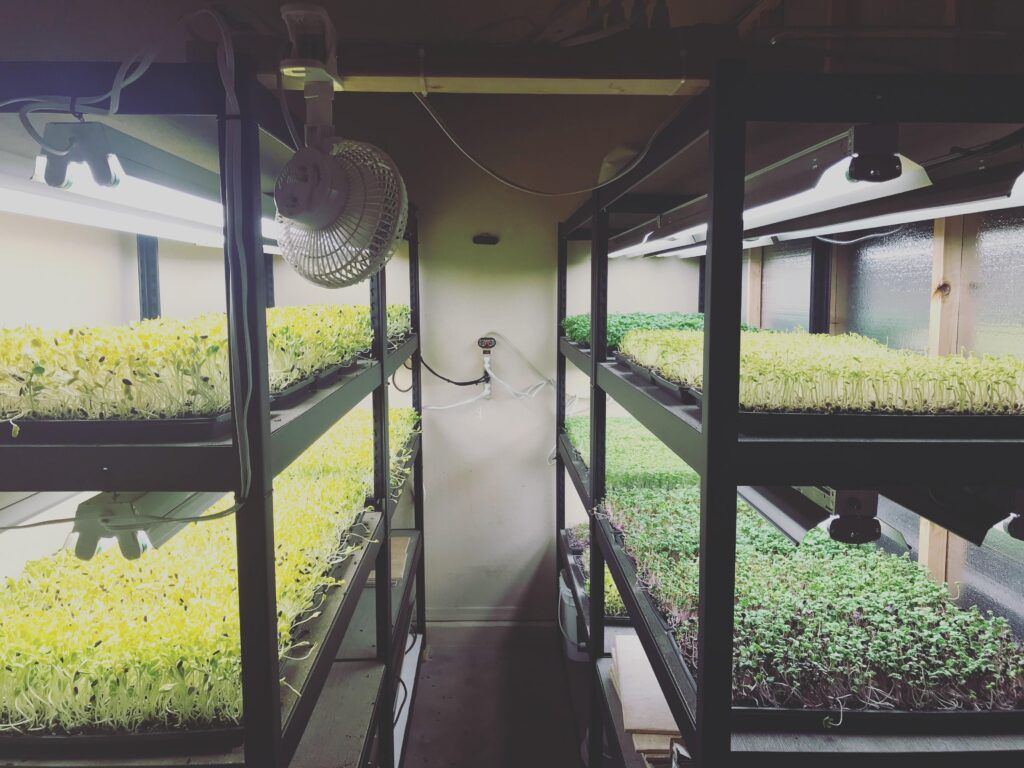
As your microgreens business grows, you’ll need strategies to scale production while maintaining quality and profitability.
Phase 1: Startup
- 10-20 trays production
- $300-500 weekly revenue
- Focus on local customers
- Simple growing setup
Phase 2: Growth
- 50-100 trays production
- $1000-2000 weekly revenue
- Multiple sales channels
- Automated systems
Phase 3: Scale
- 200+ trays production
- $3000+ weekly revenue
- Wholesale accounts
- Staff and delegation
Marketing Your Microgreens: Customer Acquisition Strategies
Effective marketing is essential for success when selling microgreens. Building relationships with customers and establishing your brand helps create steady demand for your products.
Building Restaurant Relationships
Restaurants are often your best customers when selling microgreens. Focus on building long-term partnerships with chefs who value quality ingredients.
Approach Strategy:
- Research restaurants that use fresh, local ingredients
- Visit during slow periods to speak with chefs
- Bring samples of your best varieties
- Follow up consistently but respectfully
Relationship Building:
- Deliver consistently on time and quality
- Offer seasonal varieties and specials
- Provide growing information and recipes
- Ask for feedback and adapt to preferences
Consumer Education and Branding
Many consumers are still learning about microgreens. Education helps build demand and justifies premium pricing when selling microgreens.
Educational Content Ideas:
- Nutritional benefits of different varieties
- Simple recipes and usage suggestions
- Growing process and freshness advantages
- Seasonal availability and best varieties
Marketing Channels:
- Social media with growing photos and recipes
- Farmers market demonstrations and sampling
- Partnership with local cooking schools
- Food blogger and chef collaborations
Digital Marketing for Online Sales
Online presence is increasingly important for selling microgreens, especially for direct-to-consumer sales and building brand recognition.
Website and E-commerce:
- Professional website with online ordering
- Search engine optimization for local searches
- Customer testimonials and chef endorsements
- Blog with growing tips and recipes
- Instagram with visually appealing content
- Facebook for community building and events
- YouTube for educational growing videos
- LinkedIn for B2B restaurant connections
Common Challenges When Selling Microgreens (And How to Overcome Them)
Every microgreens business faces challenges. Understanding common problems and their solutions helps you prepare and maintain consistent success when selling microgreens.
Challenge: Seasonal Demand Fluctuations
Restaurant demand often decreases during slow seasons, affecting your microgreens sales volume.
Solutions:
- Diversify customer base across multiple sales channels
- Develop holiday-specific varieties and marketing
- Offer subscription services to individual customers
- Partner with meal kit companies for steady volume
Challenge: Quality Control and Crop Failures
Disease, pests, or growing conditions can impact crop quality, affecting your ability to fulfill orders.
Solutions:
- Implement strict sanitation protocols
- Maintain backup production capacity
- Diversify growing methods and varieties
- Build relationships with other local growers for emergencies
Challenge: Price Competition
Competition from other growers or imported products can pressure your microgreens pricing.
Solutions:
- Focus on quality and consistency over low prices
- Offer unique varieties not available elsewhere
- Build strong customer relationships for loyalty
- Emphasize local freshness and sustainability
Challenge: Time Management and Scaling
Managing growing, harvesting, packaging, and sales can become overwhelming as your business grows.
Solutions:
- Implement efficient production systems and schedules
- Invest in automation where possible
- Hire help for routine tasks as revenue grows
- Focus on high-value customers and profitable varieties
Frequently Asked Questions About Selling Microgreens
Can you really make money selling microgreens?
Yes, selling microgreens can be highly profitable. Many growers report earning $300-$1000+ per week, with some established operations generating $3000+ weekly. The key is consistent quality, reliable customers, and efficient production systems. Microgreens command premium prices ($25-50 per pound) due to their nutritional value and short shelf life.
Do I need a license to sell microgreens?
Yes, most jurisdictions require licenses for selling microgreens commercially. Common requirements include a business license, food handler’s permit, sales tax permit, and sometimes vendor permits for farmers markets. Requirements vary by location, so check with your local and state authorities. FDA produce safety rules also apply to microgreens operations.
What microgreens sell for the highest price?
Premium varieties like nasturtium, purple radish, and specialty blends command the highest prices when selling microgreens, often $6-8 per ounce. However, common varieties like pea shoots, sunflower, and basic radish ($2-4 per ounce) offer better volume potential and consistent demand. Balance high-value specialties with reliable volume varieties for optimal profits.
How much should I charge for microgreens?
Pricing depends on your sales channel and local market. Wholesale prices typically range $25-40 per pound, while retail can reach $40-60 per pound. Restaurants pay $3-6 per ounce, farmers markets $4-8 per ounce. Calculate your costs (typically $3-8 per tray) and aim for at least 200-300% markup to ensure profitability when selling microgreens.
Where is the best place to sell microgreens?
The best sales channel depends on your capacity and goals. Restaurants offer consistent volume and good prices but require reliability. Farmers markets provide premium pricing and direct customer relationships. Online sales allow subscription models and broader reach. Start with local restaurants and farmers markets, then expand to multiple channels for stability when selling microgreens.
How much profit can I make per tray of microgreens?
Profit per tray typically ranges from $9-21, depending on variety, growing costs, and sales channel. A standard 1020 tray yields 8-12 ounces and costs $3-8 to produce. With selling prices of $12-30 per tray equivalent, your net profit margin should be 60-75% when selling microgreens efficiently.
How long does it take to start making money selling microgreens?
You can start generating revenue within 2-3 weeks of beginning production, as most microgreens are ready to harvest in 7-14 days. However, building a profitable customer base typically takes 2-6 months. Focus on quality, consistency, and customer relationships from day one to accelerate your path to profitability when selling microgreens.
Real Success Stories: Microgreens Farmers Making Money
Learning from successful microgreens operations can provide valuable insights for your own business. Here are examples of profitable microgreens businesses and their strategies.
Small-Scale Success: $1000+ Weekly
One Reddit user reported growing their microgreens business from $300 to $1000+ weekly profit by focusing on restaurant relationships and consistent quality. They started with a simple setup and gradually expanded their growing capacity and customer base.
Key Strategies: Focus on 3-4 reliable varieties, build strong chef relationships, maintain consistent delivery schedules, reinvest profits into expanding production capacity.
Scaling Success: $3000+ Weekly Revenue
Multiple YouTube channels document microgreens businesses generating $3000+ weekly by combining restaurant sales, farmers markets, and direct-to-consumer subscriptions. Success comes from diversifying sales channels and maintaining high quality standards.
Key Strategies: Multiple sales channels, subscription models, premium variety focus, efficient production systems, strong brand building through social media.
Small Space Success: 75 Square Feet
One grower created a profitable microgreens business in just 75 square feet, demonstrating that space constraints don’t prevent success when selling microgreens. Vertical growing systems and efficient production methods maximize output in minimal space.
Key Strategies: Vertical growing systems, high-value varieties, local market focus, efficient space utilization, streamlined operations for maximum productivity per square foot.
Ready to Start Selling Microgreens? Your Next Steps
Selling microgreens offers an excellent opportunity to build a profitable business with relatively low startup costs and high demand. Success comes from understanding your market, maintaining quality, and building strong customer relationships.
Action Steps to Start Your Microgreens Business:
- Research Your Local Market – Survey restaurants, visit farmers markets, and assess demand
- Start Small and Test – Begin with 10-20 trays to learn the process
- Obtain Necessary Licenses – Business license, food permits, and sales tax registration
- Build Your Growing System – Invest in quality equipment that can scale
- Focus on Quality and Consistency – These are your competitive advantages
- Develop Customer Relationships – Personal service builds loyalty and repeat business
- Scale Gradually – Expand production as you secure reliable customers
Remember These Key Success Factors:
- Quality always beats price competition
- Consistency builds customer trust
- Diversified sales channels reduce risk
- Customer relationships are your greatest asset
- Start small and scale systematically
- Track costs and profits carefully
- Stay current with food safety requirements
- Reinvest profits to grow your business
Start Your Microgreens Journey Today
With proper planning, quality focus, and customer dedication, selling microgreens can provide substantial income and business satisfaction. The market demand is strong, profit margins are attractive, and the barrier to entry is manageable for motivated entrepreneurs.
Your microgreens business success story starts with the first seed you plant!


